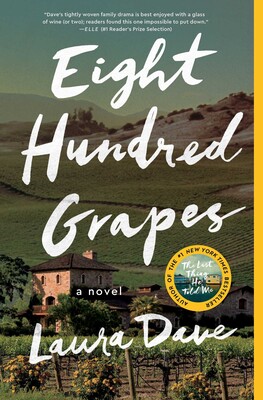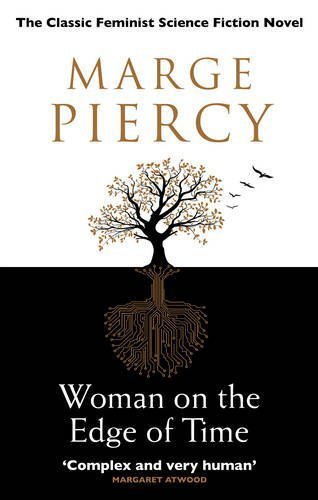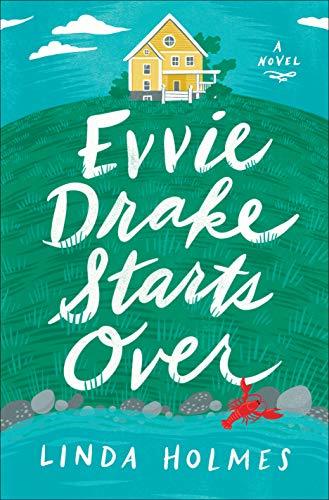Being on a cruise ship gave me the opportunity to have probably the best reading month of my life: 10 books: 8 novels + 2 works of nonfiction. Let the reviews begin!
Eight Hundred Grapes by Laura Dave
- Simon & Schuster, 2015
- Kindle ed., 274 pages
- ISBN 978-1-47-678925-5

I put this novel on my Kindle because I thought Dave’s 2021 mystery The Last Thing He Told Me was so good: “By repeatedly turning a common mystery/thriller trope on its head, Laura Dave has produced an uncommonly good novel.” What especially appealed to me about that novel is Dave’s examination of many of the foundational elements of Life Stories in Literature. This earlier novel contains many of the same themes, but it’s nowhere near as artfully developed as The Last Think He Told Me.
Georgia Ford, the protagonist of Eight Hundred Grapes, returns to her family home in California’s Sonoma Hills when she learns, just a week before her wedding, that her fiancé has been keeping a huge secret from her. In search of the comfort she’s always found at home, she instead finds a family in turmoil. Her father is about to sell the boutique vineyard and winery he’s lovingly nurtured over a lifetime to a much larger, mass-production conglomerate. And her mother, who gave up her career as a concert cellist to raise a family, harbors another man in her bedroom while her husband has moved into one of the vineyard’s outbuildings.
Yet amid all the discussion of losing or finding oneself, the psychology of Georgia’s story just doesn’t feel right to me. I read fiction partly to learn how other people manage their lives, but Georgia’s journey to discovery feels incomplete. I attribute my unease to short-changed characterization; the story line feels contrived, as if the author knew where she wanted the story to end but couldn’t convincingly get her protagonist there.
About her fiancé’s deception Georgia thinks, “something felt off in his explanation. It didn’t feel like the whole story.” That’s how I feel about this whole novel: There are a lot of complex issues here, but most of them are not fully developed. Nonetheless, I appreciate this earlier novel as a precursor to Dave’s later, much better novel, The Last Thing He Told Me.
© 2024 by Mary Daniels Brown


Woman on the Edge of Time by Marge Piercy
- © 1976
- Kindle ed., 434 pages
Like Eight Hundred Grapes, this is a novel I picked up because I liked another novel by the same author—in this case, Marge Piercy’s Gone to Soldiers (1987), a Big Book that covers World War II and its effects on the characters. When I read the description of Woman on the Edge of Time, I was curious to see what Piercy would do with a science fiction theme.
What I found in this book was not what I expected. I admit that my expectations have been shaped by recent novels that use science fiction elements to explore current society—books like Dark Matter by Blake Crouch, The Time Traveler’s Wife by Audrey Niffenegger, and The Blinds by Adam Sternbergh. But Woman on the Edge of Time is more of what I’d describe as a novel of ideas. Its point is not so much what happens in the story, but rather the ideas and ideals the book presents.
I read the Kindle edition of this book, which features an “Introduction to the 2016 Edition” by the author. In this introduction, written 40 years after the novel’s original publication, Piercy discusses why she wrote the book:
The point of writing about the future is not to predict it; I’m not pretending to be Nostradamus. The point of such writing is to influence the present by extrapolating current trends for advancement or detriment. . . . The point of creating futures is to get people to imagine what they want and don’t want to happen down the road and maybe do something about it.
Further:
I also wanted the novel to show an ecologically sound society. The lives and institutions and rituals of Mattapoisett [the future society featured in the book] all stress being a part of nature and responsible for the natural world. In imagining the good society, I borrowed from all the progressive movements of that time. Like most women’s utopias, Woman on the Edge of Time is profoundly anarchist and aimed at integrating people back into the natural world and eliminating power relationships. The nuclear family is rare in feminist utopias and banished from this novel.
I’m glad the 2016 edition of Woman on the Edge of Time was chosen for Kindle publication because this orientation helped me meet the novel on the terms in which the author intended.
The novel’s main character is Consuelo Ramos, a 37-year-old woman living in the United States. She’s one of the country’s marginalized people, living in a world of poverty and abuse, without adequate social and medical support. In her younger years she worked toward a better life, but an abusive husband and uncaring justice and medical systems took their toll. Driven into depression and alcoholism, she eventually lost custody of her daughter, Angie.
Despite being one of society’s throw-away members, Connie displays remarkable self-understanding:
in a way I’ve always had three names inside me. Consuelo, my given name. Consuelo’s a Mexican woman, a servant of servants, silent as clay. The woman who suffers. Who bears and endures. Then I’m Connie, who managed to get two years of college—till Consuelo got pregnant. Connie got decent jobs from time to time and fought welfare for a little extra money for Angie. She got me on a bus when I had to leave Chicago. But it was her who married Eddie, she thought it was smart. Then I’m Conchita, the low-down drunken mean part of me who gets by in jail, in the bughouse, who loves no good men, who hurt my daughter….”
We meet her at one of her lowest points, when she’s once again been swept up by the combined medical and justice systems interested in treating her depression, anger, and addiction to make her a fit member of society. It’s while she’s undergoing treatment that she’s contacted telepathically by Luciente, a woman from the year 2137. Luciente has chosen Connie to consult because Connie is a marginalized woman living at a time—a past time to Luciente—when society was on the verge of change. The people of 2137 want to see exactly what happened during Connie’s time that affected how society developed afterwards.
As I read Woman on the Edge of Time I kept thinking of The Mars Room, Rachel Kushner’s 2018 novel about Romy Hall, a young woman born into the world of poverty, sexual abuse, and drug addiction of San Francisco’s Tenderloin district. Romy makes a meager living as a lap dancer at the Mars Room on Market Street. But when the law fails to protect Romy and her 5-year-old son from a stalker who follows them from San Francisco to Los Angeles, Romy knows she’ll have to take care of the problem herself. By the time we meet her, she’s on her way to begin serving two consecutive life sentences in a northern California women’s prison.
While it’s somewhat unfair to compare these two novels directly, the contrast between them points up the difference between Piercy’s novel of ideas and Kushner’s novel that examines similar societal conditions by embodying them into the life story of a particular character. The Mars Room is a much more engaging reading experience than Woman on the Edge of Time, but both novels serve the purpose of presenting what it means to be a human being living in a particular society at a specific time and place.
© 2024 by Mary Daniels Brown

Evvie Drake Starts Over by Linda Holmes
- Ballantine Books, 2019
- Kindle ed., 289 pages
- ISBN 978-0-52-561924-6

I hadn’t read a previous book by this author because it’s a debut novel. But I had heard of Linda Holmes because I’d listened to her work as NPR’s popular culture reporter. Oh, and the book also features a character who’s a baseball pitcher. For those reasons I put this novel on my Kindle as a vacation read.
The book opens with a short section in which we meet Eevie (rhymes with Chevy) Drake as she’s in her car, about to leave her husband, Tim, and their big house (no kids) behind. But just as she’s about to start the car, she gets a call telling her that Tim has been badly injured in a car crash. He dies while she’s en route to the hospital.
The next sections picks the story up a year after Tim’s death. Evvie has remained reclusive, keeping to herself in the big, empty house. But when her best friend, Andy (yes, he’s a guy), suggests that she rent out the apartment in her house to his friend, a pro baseball pitcher who has lost his ability to throw the ball over the plate, things begin to change.
I usually avoid books with a hint of romance in the description, but the word baseball drew me in. There’s some social commentary in here about why Evvie is afraid to let people know that she was about to leave Tim when he so conveniently died (everybody else who knew him just loved him), and the characters are well enough developed to support the plot.
This was an entertaining vacation read, though not remarkable in any particular way.
© 2024 by Mary Daniels Brown

